Panasonic NN-ST25JMQPQ, NN-ST25JWQPQ User Manual
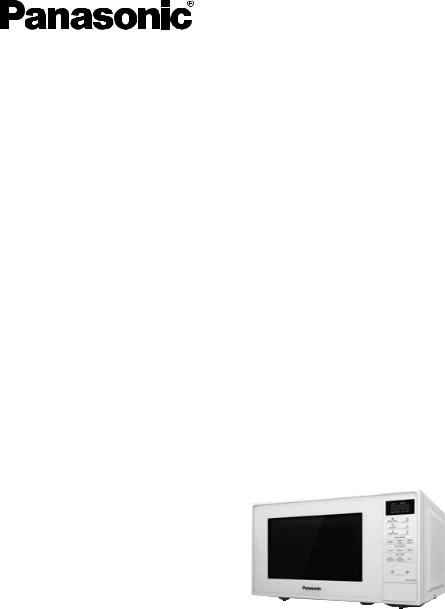
Operating Instructions
Microwave Oven
Household Use Only
Model No. NN-ST25JW NN-ST25JB NN-ST25JM
NN-ST25JW

We are glad you have chosen to purchase a PANASONIC microwave oven. Before operating this oven, please read these instructions carefully and completely, and keep them for further reference.
If you have never used a microwave oven before, you will realise that a microwave oven uses a totally different method of converting energy into heat. This requires an understanding of what exactly happens to food when placed in the oven. This is explained in the following pages.
After reading the introductory chapter, I am sure you will be able to master the basic technique and thereby develop a firm understanding of your new oven.
Start experimenting now, and enjoy the first class results you will achieve by using your new microwave oven.
Panasonic Australia Pty Ltd |
PANASONIC NZ LTD |
1 Innovation Road |
CUSTOMER CARE CENTRE |
Macquarie Park |
18 Sir Woolf Fisher Drive |
NSW 2113 |
Highbrook, Auckland 2013 |
|
Private Bag 14911 |
|
Panmure, Auckland |
|
Phone: (09) 272-0178 |
|
Fax: (09) 272-0134 |
|
Email: customerservice@nz.panasonic.com |
|
Website: www.panasonic.co.nz/support |
The serial number of this product may be found on the identification label. You should note the model number and serial number of this oven in the space provided and retain this book as a permanent record of your purchase for future reference.
MODEL NUMBER
SERIAL NUMBER
DATE OF PURCHASE

Contents |
|
Important safety instructions |
2 |
General guidelines |
7 |
Containers to use |
9 |
Parts of your oven |
11 |
Control panel |
12 |
Setting the clock |
13 |
Child safety lock |
13 |
Microwave cooking and defrosting |
14 |
Multi-stage cooking |
15 |
Quick 30 feature |
16 |
Using the timer |
17 |
Auto programmes |
19 |
Auto defrost............................................................... |
19 |
Auto reheat/auto cook............................................... |
21 |
Defrosting charts |
23 |
Reheating charts |
24 |
Cooking charts |
26 |
Recipes |
30 |
Cooking and reheating guidelines |
41 |
Questions and answers |
42 |
Care of your oven |
43 |
Specifications |
44 |
Panasonic Warranty (Australia) |
46 |
Panasonic Warranty (New Zealand) |
48 |
Thank you for purchasing a Panasonic appliance.
Important Safety Instructions:
Before operating this oven, please read these instructions and precautions carefully and keep for future reference.
1

 Important safety instructions
Important safety instructions
WARNING
1.The door seals and seal areas should be cleaned with a damp cloth.
The appliance should be inspected for damage to the door seals and door seal areas and if these areas are damaged the appliance should not be operated until it has been repaired by a service technician trained by the manufacturer.
2.Liquids and other foods must not be heated in sealed containers since they are liable to explode.
3.WHEN YOUR OVEN REQUIRES SERVICING, call your local Panasonic engineer (Customer Support). It is hazardous for anyone other than a competent person to carry out any service or repair operation which involves the removal of a cover which gives protection against exposure to microwave energy.
CAUTION
1. Do not attempt to tamper with or make any adjustments or repairs to the door, control panel housing, safety interlock switches or any other part of the oven. Do not remove the outer panel from the oven which gives protection against exposure to microwave energy. Repairs should only be done by a qualified service person.
2. Do not operate this appliance if it has a damaged CORD OR PLUG, if it is not working properly, or if it has been damaged or dropped. It is dangerous for anyone other than a service technician trained by the manufacturer to perform repair service.
3. If the supply cord is damaged, it must be replaced by the manufacturer, its service agent or similarly qualified person in order to avoid a hazard.
4. This appliance is not intended for use by persons (including children) with reduced physical, sensory or mental capabilities, or lack of experience and knowledge unless they have been given supervision or instruction concerning use of the appliance by a person responsible for their safety. Children should be supervised to ensure that they do not play with the appliance.
5. The microwave oven is intended for heating food and beverages. Drying of food, newspaper or clothing and heating of warming pads, slippers, sponges, damp cloth and similar may lead to risk of injury, ignition or fire.
6. Before use, check that utensils/ containers are suitable for use in microwave ovens.
7. The oven will only operate with the door closed.
8. When the oven is not being used, do not store any objects other than oven accessories
inside the oven in case it is 2 accidentally turned on.

9. The appliance shall not be operated WITHOUT FOOD IN
THE OVEN.
Operation in this manner may damage the appliance.
10.If smoke or a fire occurs in the oven, press Stop/Reset, and leave the door closed in order to stifle any flames.
Disconnect the power cord, or shut off the power at the fuse or the circuit breaker panel.
11.The oven lamp must be replaced by a service technician trained by the manufacturer. Do not attempt to remove the outer casing from the oven.
Installation
Examine your microwave oven
Unpack the oven, remove all packing material, and examine the oven for any damage such as dents, broken door latches or cracks in the door. If you find any damage, notify your dealer immediately. Do not install a damaged microwave oven.
Earthing instructions
IMPORTANT: THIS UNIT HAS TO
BE PROPERLY EARTHED FOR PERSONAL SAFETY.
If your AC outlet is not earthed, it is the personal responsibility of the customer to have it replaced with a properly earthed wall socket.
Operation voltage
The voltage has to be the same as specified on the label on the oven. If a higher voltage than specified is used, it may cause a fire or other damages.
WE CERTIFY THAT THIS MICROWAVE OVEN HAS BEEN
INSPECTED AND COMPLIES WITH THE REQUIREMENTS OF REGULATION 3, SUBCLAUSE(2), OF THE
MICROWAVE OVENS
REGULATIONS 1982.
(This statement applicable only to New Zealand.)
Placement of the oven
This appliance is intended to be used in household and similar applications such as:
••staff kitchen areas in shops, offices and other working environments;
••farm houses;
••by clients in hotels, motels and other residential environments;
••bed and breakfast type environments.
1. Place the oven on a flat and stable surface, more than
85 cm above the floor.
The appliance is freestanding type and shall not be placed in a cabinet.
2. When this oven is installed, it should be easy to isolate the appliance from the electricity supply by pulling out the plug or operating a circuit breaker.
3
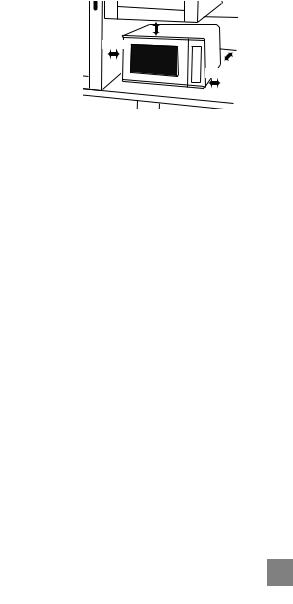
 Important safety instructions
Important safety instructions
3. For proper operation, ensure a sufficient air circulation for the oven.
Counter-top use:
Allow 15 cm of space on the top of the oven, 10 cm at the back and on 5 cm both sides.
|
15 cm |
5 cm |
10 cm |
|
5 cm |
|
counter top |
If one side of the oven is placed flush to a wall, the other side or top must not be blocked.
4. Do not place this oven near an electric or gas cooker range.
5. The feet should not be removed.
6. This oven is only for household usage. Do not use outdoors.
7. Avoid using the microwave oven in high humidity.
8. The power cord should not touch the outside of the oven. Keep the cord away from hot surfaces. Do not let the cord hang over the edge of a table or work top. Do not immerse the cord, plug or oven in water.
9. Do not block the air vents on the left side and back of the oven. If these openings are blocked during operation the oven may overheat. In this case the oven is protected by a thermal safety device and
resumes operation only after cooling down.
10.When it becomes necessary to replace the oven light, please consult your dealer.
Accessories
The oven comes equipped with a variety of accessories. Always follow the directions given for use of the accessories.
Roller ring
QQThe roller ring and the oven floor should be cleaned frequently to prevent noise and build-up of remaining food.
QQThe roller ring must always be used for cooking together with the glass tray.
Glass tray
QQAlways operate the oven with the roller ring and glass tray in place.
QQOnly use the glass tray specifically designed for this oven. Do not substitute with any other glass tray.
QQIf the glass tray is hot, let it cool before cleaning or placing in water.
QQThe glass tray can turn in either direction.
QQIf the food or cooking vessel on the glass tray touches the oven walls and stops the tray rotating, the tray will automatically rotate in the opposite direction. This is normal. Open oven door, reposition the food and restart.
QQDo not cook foods directly on the glass tray unless indicated in recipes. Always place food in a microwave safe dish.
QQWhile cooking, the glass tray may vibrate. This will not affect cooking performance.
4

Important
If the recommended cooking time is exceeded, the food will be spoiled and in extreme circumstances could catch fire and possibly damage the interior of the oven.
Short cooking time
As microwave cooking time is much shorter than other cooking methods, it is essential that recommended cooking time is not exceeded without first checking the food.
Factors that may affect cooking time are: preferred degree of cooking, starting temperature, altitude, volume, size and shape of foods and utensils used. As you become familiar with the oven, you will be able to adjust these factors.
It is better to undercook rather than overcook foods. If food is undercooked, it can always be returned to the oven for further cooking. If food is overcooked, nothing can be done. Always start with minimum cooking time.
Small quantities of food
Take care when heating small quantities of food as these can easily burn, dry out or catch fire if cooked too long. Always set short cooking time and check the food frequently.
Foods low in moisture
Take care when heating foods low in moisture, e.g. bread items, chocolate, popcorn, biscuits and pastries. These can easily burn, dry out or catch on fire if cooked too long. We do not recommend heating foods low in moisture such as popcorn or bread.
This oven has been developed for food use only.
We do not recommend to use for heating non food items such as wheat bags or hot water bottles.
Reheating
It is essential that reheated food is served “piping hot”.
Remove the food from the oven and check that it is “piping hot”, i.e. steam is being emitted from all parts and all sauce is bubbling.
(You may choose to check the food has reached 72 °C with a food thermometer – but remember do not use this thermometer inside the microwave.)
For foods that cannot be stirred, e.g. lasagne, shepherds pie, the centre should be cut with a knife to test it is well heated through. Even if a manufacturer’s packet instructions have been followed always check the food is piping hot before serving and if in doubt return your food to the oven for further heating.
Standing time
Standing time refers to the period at the end of cooking or reheating when food is left before being eaten, i.e. it is a rest time which allows the heat in the food to continue to conduct to the centre, thus eliminating cold spots.
5

 Important safety instructions
Important safety instructions
Lids
Always remove the lids of jars and containers and takeaway food containers before you microwave the food. If the lid remains, then steam and pressure might build up inside and cause an explosion even after the microwave cooking has stopped.
Babies bottles and food jars
When reheating babies bottles always remove top and teat. Liquid at the top of the bottle will be much hotter than that at the bottom and must be shaken thoroughly before checking the temperature. This should be carried out before consumption to avoid burns. See page 41.
Boiled eggs
Eggs in their shell and whole hard-boiled eggs should not be heated in microwave ovens since they may explode even after microwave heating has ended.
Foods with skins
Potatoes, apples, egg yolk, whole vegetables and sausages are examples of food with non porous skins. These must be pierced using a fork before cooking to prevent bursting.
Paper and plastic
When heating food in plastic or paper containers, keep an eye on the oven due to the possibility of ignition. Do not use wire twist-ties with roasting bags as arcing will occur.
Do not use re-cycled paper products, e.g. Kitchen roll unless they say they are specifically designed for use in a microwave oven. These products contain impurities which may cause
sparks and/or fires when used.
6
Liquids
Microwave heating of beverages can result in delayed eruptive boiling, therefore care should be taken when handling the container. To prevent the possibility of sudden boil the following steps should be taken:
a)Avoid using straight-sided containers with narrow necks.
b)Do not overheat.
c)Stir the liquid before placing the container in the oven and again halfway through the heating time.
d)After heating, allow to stand in the oven for a short time, stirring again before carefully removing the container.
Deep fat frying
Do not attempt to deep fat fry in your oven.
Arcing
Arcing may occur accidentally if a metal container has been used or the incorrect weight of food is used.
Arcing is flashes of blue light seen in the microwave oven. If this occurs, stop the machine immediately. If the oven is left unattended and this continues it can damage the machine.
Meat thermometer
Use a meat thermometer to check the degree of cooking of joints and poultry only when meat has been removed from the microwave. If undercooked, return to the oven and cook for a few more minutes at the recommended power level. Do not leave a conventional meat thermometer in the oven when microwaving.
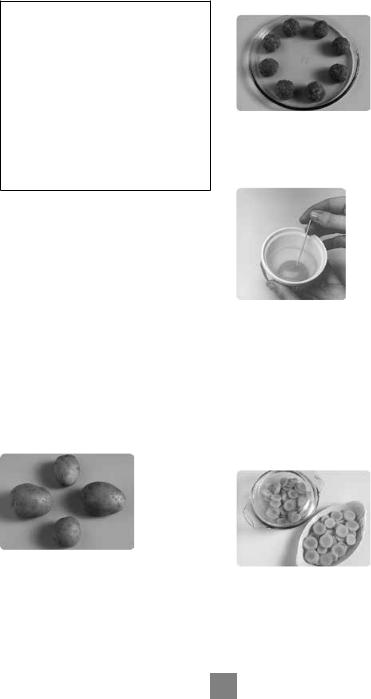
 General guidelines
General guidelines
CLEANING
As microwaves work on food particles, keep your oven clean at all times. Stubborn spots of food can be removed by using a microwave spray cleaner, sprayed onto a soft cloth. Always wipe the oven dry after cleaning.
Refer to “Care of your oven” on page 43 for details on cleaning.
The warranty only applies if the product has been used in accordance with the operating instructions under normal use and reasonable care.
STANDING TIME
Dense foods e.g. meat, jacket potatoes and cakes, require standing time (inside or outside of the oven) after cooking, to allow heat to finish conducting to the centre of the food to cook through completely. Wrap meat joints and jacket potatoes in aluminium foil while standing. Meat joints need approx. 10–15 minutes, jacket potatoes 5 minutes. Other foods such as plated meals, vegetables, fish etc. require
2–5 minutes standing. If food is not cooked after standing time, return to the oven and cook for additional time. After defrosting food, standing time should also be allowed.
QUANTITY
Small quantities cook faster than large quantities, and small meals will reheat more quickly than large portions.
SPACING
Foods cook more quickly and evenly if spaced apart. NEVER pile foods on top of each other.
PIERCING
The skin or membrane on some foods will cause steam to build up during cooking.
These foods must be pierced or a strip of skin should be peeled off before cooking to allow the steam to escape. Eggs, potatoes, apples, sausages etc, will all need to be pierced before cooking. DO NOT ATTEMPT TO BOIL EGGS IN THEIR SHELLS.
COVERING
Cover foods with microwave cling film or a lid. Cover fish, vegetables, casseroles, soups. Do not cover cakes, sauces, jacket potatoes or pastry items.
7
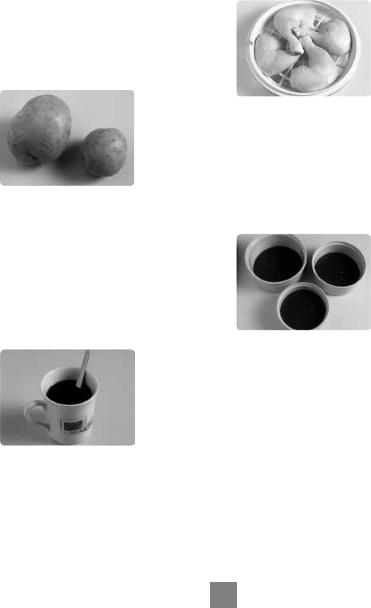
 General guidelines
General guidelines
MOISTURE CONTENT
Many fresh foods e.g. vegetables and fruit, vary in their moisture content throughout the season. For this reason cooking time may have to be adjusted. Dry ingredients e.g. rice, pasta, can dry out during storage so cooking time may differ.
DENSITY
Porous airy foods heat more quickly than dense heavy foods.
SHAPE
ARRANGING
Individual foods e.g. chicken portions or chops, should be placed on a dish so that the thicker parts are towards the outside.
CHECKING FOOD
Even shapes cook evenly. Food cooks better by microwave when in a round container rather than square.
STARTING TEMPERATURE
The colder the food, the longer it takes to heat up. Food from a fridge takes longer to reheat than food at room temperature. Food temperature should be between 5 and 8 °C before cooking.
It is essential that food is checked during and after a recommended cooking time, even if an AUTO PROGRAMME has been used (just as you would check food cooked in a conventional oven). Return the food to the oven for further cooking if necessary.
DISH SIZE
LIQUIDS
All liquids must be STIRRED BEFORE, DURING AND AFTER heating. Water must be stirred before and during heating, to avoid eruption.
Do not heat liquids that have previously been boiled. DO NOT OVERHEAT.
TURNING AND STIRRING |
|
Some foods require stirring during |
|
cooking. Meat and poultry should be |
|
turned after half of the cooking time. |
8 |
|
Follow the dish sizes given in the recipes, as these affect the cooking and reheating times.
A quantity of food spread in a bigger dish cooks and reheats faster.
CLING FILM
Cling film helps keep the food moist and the trapped steam assists in speeding up cooking time. Pierce before cooking to allow excess steam to escape. Always take care when removing cling film from a dish as the build-up of steam will be very hot.
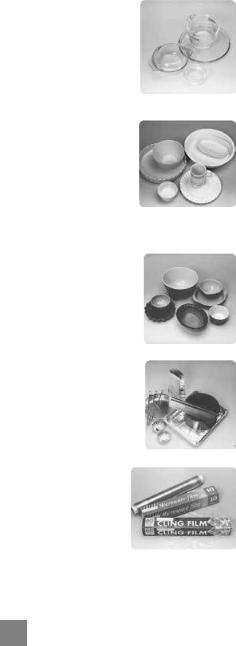
 Containers to use
Containers to use
Choosing the correct container is a very important factor in deciding the success or failure of your cooking.
OVEN GLASS
Glass that is heat resistant e.g. Pyrex®, is ideal, and can be used.
Do not use glass which may crack due to the heat from the food. Do not use lead crystal which may crack or arc.
CHINA AND CERAMIC
Glazed china plates, saucers, bowls, mugs and cups can be used if they are heat resistant.
Porcelain and ceramic are also ideal. Fine bone china should only be used for reheating for short period of time, otherwise the change in temperature may crack the dish or craze the finish. Do not use dishes with a metal rim or pattern. Do not use jugs or mugs with glued handles, since the glue can melt in a microwave.
POTTERY, EARTHENWARE, STONEWARE
Only use if completely glazed. Do not use if partially glazed or unglazed, as they are able to absorb water which will absorb microwave energy, making the container very hot and slowing down the cooking of food.
FOIL/METAL CONTAINERS
NEVER ATTEMPT TO COOK IN FOIL OR METAL containers – the microwaves cannot pass through and the food will not heat evenly – this may also damage your oven. Use wooden kebab sticks instead of metal skewers.
CLING FILM
Use microwave cling film to cover food that is to be reheated, or cooked, ON MICROWAVE ONLY taking care to avoid the film being in direct contact with the food.
9
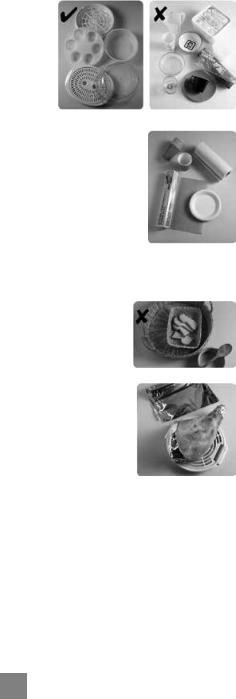
 Containers to use
Containers to use
PLASTIC
Many plastic containers are designed for microwave use. Only use containers if they are designed for microwave use. Do not use Melamine as it will scorch. Do not use plastic for cooking foods high in sugar or fat or foods that require long cooking time e.g. brown rice. Never cook in margarine containers or yogurt pots, as these will melt with the heat from the food.
PAPER
Plain white kitchen paper (kitchen towel) can be used for covering blind pastry cases and for covering bacon to prevent splattering ONLY USE FOR SHORT COOKING TIME. NEVER RE-USE A PIECE OF KITCHEN TOWEL. Avoid kitchen paper containing manmade fibers. Check that branded re-cycled kitchen towel is recommended for microwave use. Do not use waxed or plastic coated cups as the finish may melt in the oven. Greaseproof paper can be used to line the base of dishes and to cover fatty foods. White paper plates can be used for SHORT REHEATING
TIMES, ON MICROWAVE ONLY.
WICKER, WOOD, STRAW BASKETS
Do not use these items in your microwave. With continued use and with prolonged exposure they will crack and could ignite.
ALUMINIUM FOIL
Small amounts of smooth aluminium foil can be used to SHIELD joints of meat during defrosting. As the microwaves cannot pass through the foil this prevents the shielded parts from overcooking or overdefrosting.
The foil must not touch the sides or roof of the oven, as this may cause arching and damage your oven.
ROASTING BAGS
These are useful when slit up one side to tent a joint of meat when roasting by power and time. DO NOT USE THE METAL TWISTS SUPPLIED.
10
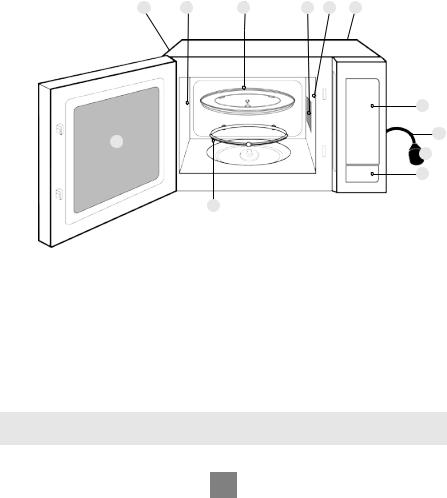
 Parts of your oven
Parts of your oven
1. Door release button |
2. Oven window |
Press to open the door. Opening |
3. Air vents |
the door during cooking will stop |
4. Microwave feed guide |
the cooking process without |
(Do not remove.) |
cancelling the programme. It is |
5. External air vents |
quite safe to open the door at any |
6. Control panel |
time during a cooking programme |
7. Power supply cord |
and there is no risk of microwave |
8. Plug |
exposure. Cooking resumes after |
9. Glass tray |
the door is closed and Start is |
10. Roller ring |
pressed. |
|
5 |
3 |
9 |
4 |
3 |
5 |
2
10
6
7
8
1
Identification label is attached on the oven.
Note
This illustration is for reference only.
11
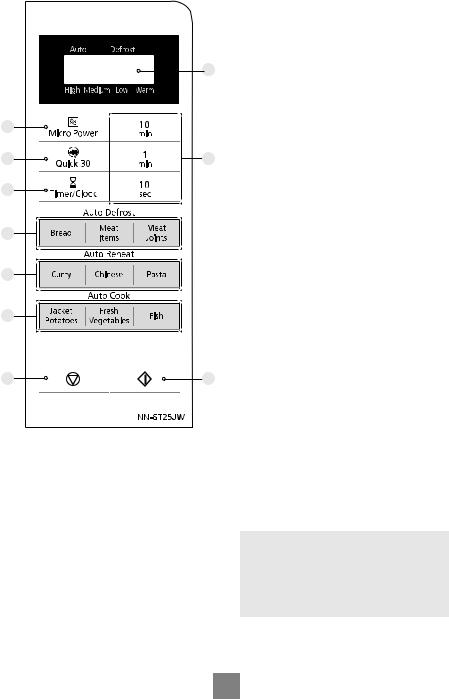
 Control panel
Control panel
|
1 |
2 |
|
3 |
5 |
4 |
|
6
7
8
9 |
10 |
•Your control panel may have differences in appearance, but the words on the pads and functionality will be the same.
1 Display window
2 Micro Power pad
3 Quick 30 pad
4 Timer / Clock pad
5 Time pads
6 Auto Defrost pads
7 Auto Reheat pads
8 Auto Cook pads
9 Stop / Reset pad:
Before Cooking:
One press clears your instructions.
During Cooking:
One press temporarily stops the cooking process. Another press cancels all your instructions and a colon or the time of day will appear in the display.
10Start pad
One press allows oven to begin functioning. If door is opened or Stop/Reset is pressed once during oven operation, Start must be pressed again to restart oven.
Beep sound
When a pad is pressed correctly a beep will be heard. If a pad is pressed and no beep is heard, the unit has not or cannot accept the instruction. The oven will beep twice between programmed stages. At the end of any complete programme, the oven will beep 5 times and “End” will be displayed.
Note
If Start is not pressed for 6 minutes after cooking programme setting, the oven will automatically cancel the cooking programme. The display will revert back to clock or colon.
12

 Setting the clock
Setting the clock
When the oven is plugged in for the first time, “88.88” appears in display.
Example: To set 11:25am
|
|
|
|
Press 11 times. |
Press 5 times. |
|||||||||||
|
|
|
|
(to set hours) |
(to set 1 minute) |
|||||||||||
|
|
|
|
|
|
|
|
|
|
|
|
|
|
|
|
|
|
|
|
|
|
|
|
|
|
|
|
|
|
|
|
|
|
|
|
|
|
|
|
|
|
|
|
|
|
|
|
|
|
|
|
|
|
|
|
|
|
|
|
|
|
|
|
|
|
|
|
|
|
|
|
|
|
|
|
|
|
|
|
|
|
|
||
|
|
|
|
|
|
Press twice. |
|
|
|
|
|
|
|
|||
|
|
|
|
|
|
(to set 10 minutes) |
||||||||||
Press Timer/Clock |
Enter time of day. |
|
|
|
Press Timer/Clock. |
|||||||||||
twice. |
|
|
|
|
|
|
|
|
|
The colon stops |
||||||
A colon starts to blink. |
|
|
|
|
|
|
|
|
|
blinking. Time of day |
||||||
|
|
|
|
|
|
|
|
|
|
|
|
|
is now locked into |
|||
|
|
|
|
|
|
|
|
|
|
|
|
|
the display. |
|||
Notes
1.To reset the clock, repeat step 1 through to step 3, as above.
2.The clock will keep the time of day as long as the oven is plugged in and electricity is supplied.
3.This is a 12 hour clock.
 Child safety lock
Child safety lock
This feature will make the oven controls inoperable; however, the door can be opened. Child Lock can be set when the display shows a colon or the time.
To Set: |
To Cancel: |
Press Start 3 times in 10 seconds.
The clock will disappear. Actual time will not be lost. “Child” is indicated in the display.
Press Stop/Reset 3 times in 10 seconds.
The clock will reappear in the display.
13

 Microwave cooking and defrosting
Microwave cooking and defrosting
The glass tray must always be in position when using the oven.
Press Micro Power |
Set the cooking time. |
Press Start. |
to select the desired |
Your oven can be |
The time |
power level. |
programmed for up to |
counts down |
|
99 minutes 50 seconds in |
in the display. |
|
Medium, Low, Warm and |
|
|
Defrost power. High power |
|
|
can be programmed for up to |
|
|
30 minutes. |
|
Press |
Power Level |
|
once |
High |
800 W |
twice |
Defrost |
270 W |
3 times |
Medium |
700 W |
4 times |
Low |
520 W |
5 times |
Warm |
200 W |
Example of Use
Boil water. Cook fresh fruit, vegetables, rice, pasta and noodles.
Thaw foods.
Cook poultry, meat, cakes and desserts. Heat milk.
Cook eggs, cheeses, fish, pot roasts, casseroles and meat loaves. Melt chocolate.
Keep cooked foods warm, simmer slowly.
Notes
1.The oven will automatically work on High microwave power if a cooking time is entered without the power level previously being selected.
2.While cooking, the glass tray may vibrate. This will not affect cooking performance.
3.For MULTI-STAGE COOKING, refer to page 15.
4.STANDING TIME can be programmed after microwave power and time setting. Refer to page 17.
5.DO NOT cook with any metal accessory in the oven.
6.Always check the food during defrosting by opening the door then restarting. It is not necessary to cover food during defrosting. To ensure an even result, stir, turn or separate several times during defrosting. For large joints and poultry, turn halfway through defrosting and protect ends and tips with foil.
Refer to Defrosting guidelines on page 20 for details.
14
